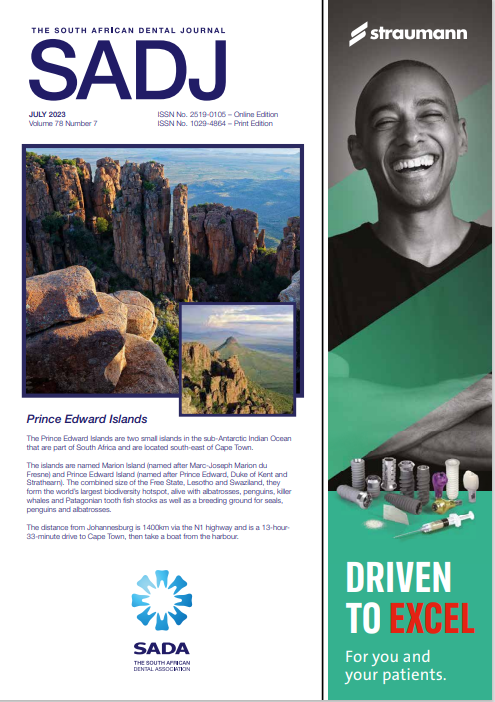Bacterial contamination of curing light guides: prevalence and students’ knowledge and awareness of measures to maintain sterility
DOI:
https://doi.org/10.17159/sadj.v78i07.17074Keywords:
infectionAbstract
It is generally accepted that inadequately sterilized dental curing light guides pose risks of infection and cross contamination.
To determine the presence and level of bacterial contamination among curing light guides used by students during patient care at a dental school in South Africa and to describe students’ knowledge and awareness of measures used to maintain their sterility. A two-part descriptive study consisting of microbiological testing and a cross-sectional survey. Swabs were collected from curing light guide tips before and after use for aerobic culture and a questionnaire was used to collect data pertaining to students’ knowledge and
awareness of measures used to maintain their sterility. The prevalence of contamination increased after use (54.5% vs 45.5%). Grades of bacterial growth higher than 1+ were not detected. Isolated bacteria were contaminants. The response rate for the questionnaire was 42.5%. Fifth-year students were overall more knowledgeable than fourth-year students (81.6% vs 67.5%) and were more aware of the existence of the different types of disposable barriers (27.5% vs 12.8%) and the impact of infection control barriers on
curing light intensity (52.4% vs 15%). Contamination occurred despite high levels of knowledge and awareness of the risk.
Downloads
References
Burke JP. Infection control – a problem for patient safety. N Engl J Med 2003; 348: 651-6 DOI: https://doi.org/10.1056/NEJMhpr020557
Van Kleef, E, Robotham JV, Jit M, Deeny SR, Edmunds WJ. Modelling the transmission of healthcare associated infections: a systematic review. BMC Infect Dis 2013; 13(1):1-13 DOI: https://doi.org/10.1186/1471-2334-13-294
Irek EO, Amupitan AA, Aboderin AO, Obadare TO. A systematic review of healthcare associated infections in Africa: An antimicrobial resistance perspective. Afr J Lab Med 2018; 7(2): 1-9 DOI: https://doi.org/10.4102/ajlm.v7i2.796
Mutters NT, Hägele U, Hagenfeld D, Hellwig E, Frank U. Compliance with infection control practices in a university hospital dental clinic. GMS Hyg Infect Control 2014; 9(3)
Cristina ML, Spagnolo AM, Sartini M et al. Investigation of organizational and hygiene features in dentistry: a pilot study. J Prev Med Hyg 2009; 50(3): 175-80
Donly KJ, Sasa IS. Dental Materials. In: Nowak AJ, Christensen JR, Mabry TR, Townsend JA, Wells MH, eds. Pediatric Dentistry,6th ed. Elsevier, 2019:293-303 DOI: https://doi.org/10.1016/B978-0-323-60826-8.00021-3
Janoowalla Z, Porter K, Shortall A, Burke F, Sammons R. Microbial contamination of light curing units: a pilot study. J Infect Prev 2010; 11(6):217-21 DOI: https://doi.org/10.1177/1757177410385488
Caughman WF, O’Connor RP, Volkmann KR, Schuster GS, Caughman GB. Oper Den Visible-light-curing devices: a potential source of disease transmission. Oper Dent 1987; 12(1):10-4
American Dental Association. Dental Curing Lights. Available https://www.ada.org/en/resources/research/science-and-research-institute/oral-health-topics/dental curing-lights [Accessed 14/06/2023]
Kohn WG, Harte JA, Malvitz DM, et al. Guidelines for infection control in dental health care settings - 2003. J Am Dent Assoc 2004;135(1): 33-47 DOI: https://doi.org/10.14219/jada.archive.2004.0019
Price RB, Ferracane JL, Hickel R, Sullivan B. The light-curing unit: An essential piece of dental equipment. Int Dent J 2020;70(6):407-17 DOI: https://doi.org/10.1111/idj.12582
Mitton BA, Wilson NH. The use and maintenance of visible light activating units in general practice. Br. Dent. J. 2001; 191:82-6 DOI: https://doi.org/10.1038/sj.bdj.4801103a
Pollington S, Kahakachchi N, van Noort R. The influence of plastic light cure sheaths on the hardness of resin composite. Oper Dent 2009; 34(6):741-5 DOI: https://doi.org/10.2341/09-024-L
Santini A. Current status of visible light activation units and the curing of light activated resin-based composite materials. Dent Update 2010; 37(4): 214-27 DOI: https://doi.org/10.12968/denu.2010.37.4.214
Hodson NA, Dunne SM, Pankhurst CL. The effect of infection-control barriers on the light intensity of light-cure units and depth of cure of composite. Prim. Dent. Care 2005; 12:61-7 DOI: https://doi.org/10.1308/1355761053695149
Scott BA, Felix CA, Price RB. Effect of disposable infection control barriers on light output from dental curing lights. J. Can. Dent. Assoc 2004; 70:105-10
McAndrew R, Lynch CD, Pavli M, Bannon A, Milward P. The effect of disposable infection control barriers and physical damage on the power output of light curing units and light curing tips. Br. Dent. J 2011;210: E12 DOI: https://doi.org/10.1038/sj.bdj.2011.312
Soares CJ, Braga SSL, Ribeiro MTH, Price RB. Effect of infection control barriers on the light output from a multi-peak light curing unit. J Dent 2020; 103:103503 DOI: https://doi.org/10.1016/j.jdent.2020.103503
Bible JE, Biswas D, Whang PG, et al. Which regions of the operating gown should be considered most sterile? Clin Orthop Relat Res 2009; 467(3): 825-30 DOI: https://doi.org/10.1007/s11999-008-0341-1
Engelkirk PG, Duben-Engelkirk J. Laboratory Diagnosis of Infectious Diseases: Essentials of Diagnostic Microbiology. Baltimore: Wolters Kluwer/Lippincott Williams & Wilkins, 2008
Williams AN, MacLea KS. Draft Genome Sequence of Dermacoccus nishinomiyaensis TSA37, Isolated from Wood Ash. Microbiol Resour Announc 2019; 8(50): e01370-19 DOI: https://doi.org/10.1128/MRA.01370-19
Kandi V, Palange P, Vaish R, et al. Emerging bacterial infection: identification and clinical significance of Kocuria species. Cureus 2016;8(8): e731 DOI: https://doi.org/10.7759/cureus.731
Al Khalaf K, O’Dowling Keane S, da Mata C, McGillycuddy CT, Chadwick BL, Lynch CD. Response rates to questionnaire-based studies in the contemporary dental literature: A systematic review. J Dent. 2022; 126:104284 DOI: https://doi.org/10.1016/j.jdent.2022.104284
Simmons BP. CDC Guidelines for the prevention and control of nosocomial infections. Guidelines for hospital environmental control. Am. J. Infect. Control 1983; 11:97-120 DOI: https://doi.org/10.1016/0196-6553(83)90030-5
Rutala WA, 1994,1995,1996 APIC Guidelines Committee. APIC guidelines for selection and use of disinfectants. Association for Professionals in Infection Control and Epidemiology, Inc. Am. J. Infect. Control 1996; 24:313-42 DOI: https://doi.org/10.1016/S0196-6553(96)90066-8
Downloads
Published
Issue
Section
License

This work is licensed under a Creative Commons Attribution-NonCommercial 4.0 International License.





.png)